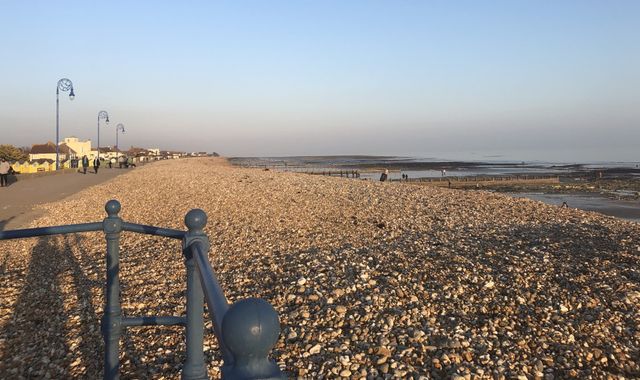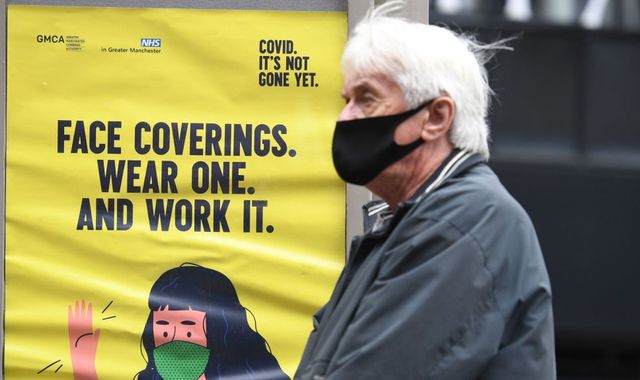Coronavirus excess fatalities: How pandemic is impacting the lives and deaths of those who don’t have COVID
Written by News on 13/10/2020
There is no good place to hear bad news – especially when it is the worst news. But when Caroline Kennedy heard the worst news she was in the worst place.

She had been diagnosed with cancer four years earlier and for four years she had had course after course of treatment. She was told the cancer might come back and so it did, but for the time being life went on.
Her family built her a summer house at the bottom of her leafy garden in north London. Soon enough they slipped into a routine: a course of chemotherapy every six months followed by a clear.
She would sit outside her summer house and watch as the seasons passed and in those in-between months it was sometimes possible to forget the diagnosis and imagine that things might return to normal.
But then this February the cancer came back.
Caroline and her family prepared for the routine to begin all over again – and for a few weeks that’s how it felt. But then Caroline suffered some complications.
This in and of itself wasn’t unusual: during her previous courses there had been complications and Caroline had had spells in hospital, but they were just about bearable thanks partly to her family, who would gather by her bed, and thanks partly to the familiar faces at the hospital.
But this time when the complications stuck the country had gone into lockdown.
So this time when she went into hospital, it was on her own. This time she wasn’t allowed to have her family around her bed and her regular team of doctors were not allowed into her room because of COVID-19 restrictions.
So when Caroline heard the worst news, that there was nothing more that could be done for her and that she might only have months left to live, it came from a consultant she didn’t know. It came without her family by her side.
There is no good place to hear bad news but this was about the worst possible setting.
“When she got that news, the news we were all dreading, all we wanted was to be there for her – that was all she needed,” said her daughter Charlotte. “She really needed a support system around her.”
This was in April, at the height of the pandemic.
Caroline stayed in hospital for the next seven weeks – alone, isolated and despairing. Eventually her family realised that the only way they could see her was to bring her home. But, at that stage she was a shadow of her former self, said Charlotte.
“She was really struggling to get her head around to the inevitability of what she faced and she came out of hospital with no real fight left.”
The following weeks were difficult for Caroline and her family as they attempted to care for her. The house they had lived in together for decades became a makeshift hospital. Her husband and her two daughters became her nurses and carers.
And since this was all being played out in the shadow of COVID-19 they struggled to get the kind of help they might have had in normal times.
“I don’t think you ever can be prepared for that,” said Charlotte. “We suddenly realised how much care mum needed and what that meant – and that was 24/7 care, seven days a week. Meanwhile we were all trying to juggle that with full-time work while trying to make sense of the world in the face of a global pandemic.”
Were it not for COVID-19 the chances are Caroline would have died in a hospice, but when the end came in July it was in her house. She had her family around her, but it was not an easy end. It was difficult and arduous, and one which continues to haunt her family.
“We now have to live in this house,” said Charlotte. “It is still home, but there are some painful memories from the last year or so, and trying to erase them one way or another during a pandemic when we’re all still working from home – it’s a minefield.”
Painful as it is, it is worth considering Caroline and her family’s story because it helps make sense of an unexplained and unexplored phenomenon that has perplexed statisticians during the pandemic.
Much attention has been paid to the sharp rise in deaths at care homes and hospitals. Much thought has been given to the impact of lockdowns on the economy and on public health.
But something else has happened during this pandemic: our experience of “normal” death has changed too.
Even after lockdown came to an end and normal life supposedly resumed, the number of people dying at home has remained stubbornly high.
In previous years, the average number who died at home during the summer and early autumn was just over 2,200.
Yet this year the average number of weekly deaths in that period has been running at over 2,900.
Long after deaths in hospitals and care homes dropped down to normal levels, deaths at home have remained elevated.
The vast majority of these so-called excess deaths are not down to COVID-19 – at least not directly. They are deaths from cancer, from heart disease, from all the other causes that commonly take people’s lives.
But as Caroline’s experience shows, even a “normal” death nonetheless feels very different in the age of coronavirus.
In part this is because the support structures which we have hitherto taken for granted have not been as easily accessible during the pandemic.
Deciding to put a sick family member or friend into a hospital or hospice is a difficult enough decision at the best of times, but it becomes even more agonising when you know your access to that person could be limited.
This might explain why people have decided to keep dying family members at home.
According to Sir David Spiegelhalter, Winton Professor of the Public Understanding of Risk in the Statistical Laboratory at the University of Cambridge, the shift in deaths from hospitals to homes “shows no sign of changing”.
“It’s just continued all the way through the summer and is just going on and on. It’s almost as if this is a permanent change from the epidemic,” he said.
“This isn’t necessarily a bad thing: people do generally want to die at home. A well-supported home death is as good as can be expected. But we really don’t know what the quality of these deaths has been throughout the pandemic.”
According to those who work in hospice care, that task has become all the more challenging over the past six months.
Selina Rodgers, a health care assistant at St Luke’s Hospice in Devon said: “We see a lot of death in what we do, but during this last six to seven months there’s been more than ever.
“We can lose four patients just in one day. We can go off shift and have our two days off, come back to work and all our patients have changed because they’ve died.
“We’re getting our referrals in later and people are dying a lot sooner. It’s almost like crisis intervention: we’re going in for many the last 24-48 hours of their life and making sure they’re comfortable.
“People aren’t going for routine appointments at hospitals. I think this time next year we see even more deaths because people aren’t having the treatment they need.”
And with excess deaths at home showing no sign of coming to an end, there will be more need for remote hospice care in the coming months.
However, the sector is reliant on charitable donations and, according to a new survey from Hospice UK, seen exclusively by Sky News, the sector is struggling to provide the support necessary for those who are dying, either at home or in hospice settings.
More than two-fifths of the hospices surveyed – 44% – think they will have to reduce the volume of services they can provide for palliative care and end of life. Around 93% are concerned that people could miss out on the support they require.
In short, that support which Caroline’s family so desperately needed and struggled to get might be even more difficult to come by in the coming years.
There is another explanation for those excess deaths from causes other than COVID-19. This is that they are being lifted by the indirect consequences of the pandemic – be that the lockdown or the rationing of healthcare to non-COVID patients.
We know that many cancer operations have been cancelled during the pandemic, and consultants warn that this is likely to worsen cancer outcomes in the coming years.
Consider the story of Adrian Rogers, a scaffolding supervisor in his 40s, who was diagnosed with stage 4 bowel cancer in 2018.
The cancer had spread to his liver but the initial courses of chemotherapy were promising – so promising that the tumours on the bowel stopped growing and what had looked inoperable suddenly looked like it might be treatable.
Adrian was scheduled to have a life-saving operation to remove 70% of his liver at Manchester Royal Infirmary in early April.
Then came lockdown.
“The surgeon rang me from Manchester and asked me whether I was still happy to go ahead with it,” said Adrian. “I said yes: because it was my last chance. But the board of directors said it would involve too much risk, because I’d have to go into intensive care after the operation for observation.”
The operation was cancelled. In the meantime, with chemotherapy paused, the cancer on his bowels and liver returned with a vengeance.
The operation had always been a glimmer rather than a ray of hope, but now his cancer is terminal and he is receiving palliative care treatment. His family is trying to save up for a private treatment to extend his life.
“It was devastating. Absolutely devastating. We worked so hard and kept going with the chemo to get to that point – only for COVID to come and it all changed and the op got cancelled,” said his wife Amanda.
Adrian’s was one of thousands of cancelled operations during the pandemic.
:: Subscribe to the Daily podcast on Apple Podcasts, Google Podcasts, Spotify, Spreaker
For some, those cancellations were mostly an inconvenience but for others they were the difference between life and death.
Indeed, some cancer charities warn that the cumulative impact of these cancellations will build and build in the coming months – especially if healthcare is rationed again this autumn and winter.
None of these individual stories can tell the full story of what is happening beneath Britain’s mortality data, but they do underline some of the forces at play in the numbers.
They illustrate the complexity of what is happening in streets around this country.
And with Britain now facing a second surge of the disease, it is becoming clear that COVID-19 will shape the way we live our lives, and indeed die our deaths, for some time longer.
(c) Sky News 2020: Coronavirus excess fatalities: How pandemic is impacting the lives and deaths of those who don’t have COVID







